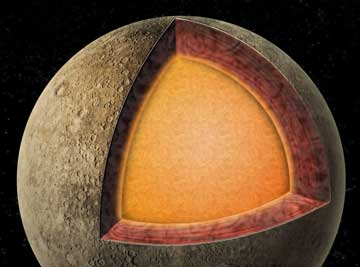|
NEWS NOTES — NEWS
Planetary geology
Mercury's gooey center
 Nicolle Ragger Fuller, National Science Foundation |
| Mercury, the closest planet to the sun, has a large core, which scientists now know is partially molten and therefore could create a magnetic field around the planet. |
Solving a mystery that puzzled astronomers for decades, scientists have determined that Mercury has a liquid core similar to Earth’s. The discovery not only supports the idea that each of the terrestrial planets in our solar system — Earth, Mercury, Venus and Mars — may have a liquid core, but it also has implications for how these planets initially formed.
In the mid-1970s, NASA’s Mariner 10 spacecraft performed the first flyby of Mercury and made a startling discovery: The tiny planet closest to the sun has a magnetic field, albeit a weak one. What generated that field was unclear, however. On Earth, fluid circulating in the liquid metal outer core, partially driven by the planet’s rotation, generates its magnetic field. As the conductive fluid continues to flow across the field, it creates electric currents that continually regenerate the field. This self-sustaining process is known as a “dynamo” effect. Mars’ magnetic field is not generated by its liquid core, but instead by large areas of old, strongly magnetized crust in its southern hemisphere, which may be remnants of a now-defunct internal dynamo. Venus, meanwhile, has a liquid outer core but only a very faint magnetic field, possibly because the planet’s rotation rate, which drives convection in the fluid, is extremely slow.
For Mercury’s magnetic field to come from an Earth-like dynamo in its core, at least the outer core of the tiny planet would have to be molten, says Jean-Luc Margot, an astronomer at Cornell University in Ithaca, N.Y. Without new data about the planet since Mariner 10, however, scientists have only speculated about the planet’s core over the last three decades.
But Margot and a team of researchers have come up with a new method to answer this question. They measured tiny deviations in Mercury’s spin to determine whether the core is solid or liquid, one of the necessary conditions for a Mercury dynamo. Margot likens the team’s method of analyzing the tiny changes in Mercury’s rotation to measuring light reflecting off a spinning disco ball. “You see a pattern of light sweeping across the wall as it spins,” he says. “If you have two markers on the wall, and time how long it takes for a pattern to go from one marker to the next, you can figure out the spin rate.”
Similarly, to measure Mercury’s spin rate, the team used two points on Earth’s surface: radio telescopes separated by more than 3,200 kilometers (about 2,000 miles). The researchers then bounced radio waves off Mercury and recorded the reflected signals at the two telescopes during more than 20 observation periods from 2002 to 2006.
Although the researchers expected to see small variations in the planet’s spin rate, using this method they were also able to measure the size, or amplitude, of those variations. Earlier, they had determined that the amplitude of those variations should be twice as large if the core is molten rather than solid. The high amplitudes they measured suggest that Mercury’s core is indeed liquid, the team reported May 4 in Science.
Although the discovery that the core is molten was not entirely a surprise, particularly for those who theorize it may be generating the planet’s magnetic field, there are still many questions to answer — such as how the core has managed to stay liquid, Margot says. “To maintain a molten core on Mercury is not simple,” Margot says. “The planet is so small that it radiates heat very efficiently.”
What might keep the core liquid, he says, is sulfur, which would lower the core’s melting point. Sulfur, however, would not have existed so near to the sun during the planet’s formation, but it would have been present farther out in the solar system. Therefore, Mercury may be an aggregate of planetary material from across the solar system rather than an amalgam of material from within its own orbit.
If Mercury is indeed such an aggregate, it has that in common with Venus and Earth, says David Stevenson, a planetary scientist at Caltech in Pasadena, Calif. Venus has clouds of sulfuric acid and Earth has water, yet neither substance existed so close to the sun while these planets were forming.
Although questions of planetary formation are still uncertain, Margot’s discovery that Mercury’s core is molten appears “clear-cut,” Stevenson says. In fact, he says, “I think this fits in with a bigger picture — that all of the terrestrial planets probably have liquid outer cores.”
Other lingering questions — including both the actual size of Mercury’s core (thought to be about half the planet’s total volume) and whether Mercury does indeed have a dynamo at its heart — will likely be answered when NASA’s Messenger spacecraft flies by Mercury in 2008, Stevenson says. The first new mission to Mercury in more than 30 years, Messenger will measure the composition of the planet’s surface as well as its atmosphere and magnetosphere, he says. “We’re going to get everything.”

 Subscribe
Subscribe


